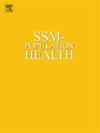与军队有关的抑郁症状的长期轨迹。
IF 3.6
2区 医学
Q1 PUBLIC, ENVIRONMENTAL & OCCUPATIONAL HEALTH
引用次数: 0
摘要
目的:本研究使用美国全国样本,估计并比较了按服兵役分层的抑郁症状轨迹模式。这项研究随后检查了社会人口因素之间的联系,这些因素被理论化,以塑造参军和轨迹模式。方法:数据来自全国青少年至成人健康纵向研究,这是一项具有全国代表性的研究,追踪了从青春期(1994-1995)到中年(2016-2018)的参与者。使用潜在生长混合模型来估计平民(n = 17,644)和在军队服役的参与者(n = 1266)的抑郁症状轨迹。用多项回归检验轨迹隶属度与社会人口学因素之间的关系。结果:4类线性模型最能代表轨迹。“低级”是最大的阶层,占平民的74.4%,占服役人员的70.4%。第二大阶层是“先低后增”,由13.6%的平民和19.6%的军人组成。第三个最小的阶层,“高后低”阶层,包括8.8%的平民和4.5%的军人。到中年时,出现了抑郁症状严重的“不断增加”阶层,包括3.2%的平民和5.5%的军人。性别和家庭结构与轨迹成员关系密切相关。讨论:在接受治疗的患者中,有较大比例的人处于“增加”的轨迹,其特征是到中年时抑郁症状高,这强调了在整个生命过程中继续筛查抑郁症状的必要性。家庭结构和性别对抑郁症症状支持的关联要求将家庭结构概念化为健康的社会决定因素,并继续投资于妇女健康。本文章由计算机程序翻译,如有差异,请以英文原文为准。
Long-term trajectories of depressive symptoms by military affiliation
Objectives
Using a national sample of Americans, this study estimated and compared patterns of depressive symptom trajectories stratified by military service. This study then examined associations between sociodemographic factors theorized to shape entry into military service and trajectory patterns.
Method
Data came from the National Longitudinal Study of Adolescent to Adult Health, a nationally representative study that followed participants from adolescence (1994–1995) through midlife (2016–2018). Latent growth mixture modeling was used to estimate depressive symptom trajectories among civilians (n = 17,644) and participants who served in the military (n = 1266). Associations between trajectory membership and sociodemographic factors were tested with multinomial regression.
Results
Trajectories were best represented by 4-class linear models. “Low” was the largest class, representing 74.4% of civilians and 70.4% of those who served. The second largest class, “low then increasing,” was comprised of 13.6% of civilians and 19.6% of service members. The third smallest class, “high then decreasing” class, included 8.8% of civilians and 4.5% of service members. An “increasing” class emerged with high depressive symptoms by midlife, comprised of 3.2% of civilians and 5.5% of those who served. Gender and family structure had robust associations with trajectory membership.
Discussion
A larger percentage of those who served were in the “increasing” trajectory characterized by concerningly high depressive symptoms by midlife, underscoring the need for continued screening in depressive symptoms throughout the life course. Associations between family structure and gender on depressive symptoms support calls for conceptualizing family structure as a social determinant of health and continued investment in women's health.
求助全文
通过发布文献求助,成功后即可免费获取论文全文。
去求助
来源期刊

Ssm-Population Health
PUBLIC, ENVIRONMENTAL & OCCUPATIONAL HEALTH-
CiteScore
6.50
自引率
2.10%
发文量
298
审稿时长
101 days
期刊介绍:
SSM - Population Health. The new online only, open access, peer reviewed journal in all areas relating Social Science research to population health. SSM - Population Health shares the same Editors-in Chief and general approach to manuscripts as its sister journal, Social Science & Medicine. The journal takes a broad approach to the field especially welcoming interdisciplinary papers from across the Social Sciences and allied areas. SSM - Population Health offers an alternative outlet for work which might not be considered, or is classed as ''out of scope'' elsewhere, and prioritizes fast peer review and publication to the benefit of authors and readers. The journal welcomes all types of paper from traditional primary research articles, replication studies, short communications, methodological studies, instrument validation, opinion pieces, literature reviews, etc. SSM - Population Health also offers the opportunity to publish special issues or sections to reflect current interest and research in topical or developing areas. The journal fully supports authors wanting to present their research in an innovative fashion though the use of multimedia formats.
 求助内容:
求助内容: 应助结果提醒方式:
应助结果提醒方式:


